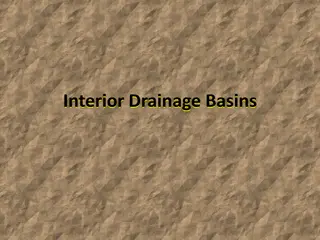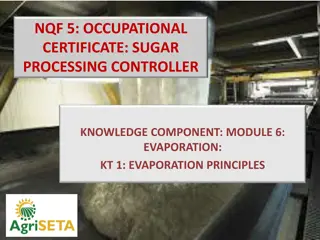Engineering Hydrology Course Overview and Great Salt Lake Evaporation Analysis
Engineering Hydrology course led by David Tarboton covers principles of hydrology, water balance concepts, and hydrologic modeling. The analysis of Great Salt Lake evaporation explores factors such as inflow, area, and precipitation to determine the average annual evaporation rate.
Download Presentation

Please find below an Image/Link to download the presentation.
The content on the website is provided AS IS for your information and personal use only. It may not be sold, licensed, or shared on other websites without obtaining consent from the author.If you encounter any issues during the download, it is possible that the publisher has removed the file from their server.
You are allowed to download the files provided on this website for personal or commercial use, subject to the condition that they are used lawfully. All files are the property of their respective owners.
The content on the website is provided AS IS for your information and personal use only. It may not be sold, licensed, or shared on other websites without obtaining consent from the author.
E N D
Presentation Transcript
CEE 3430, Engineering Hydrology David Tarboton (Richard Peralta today)
Overview Handouts Syllabus Schedule Student Information Sheet Homework 1 Web: http://www.engineering.usu.edu/dtarb/cee3430 Outline for today Review Syllabus and Schedule Introduce the Hydrologic Cycle and Water Balance Concepts
Texts Ground and Surface Water Hydrology, by Mays, 2011 (Chapters 1-4 and 7-9) Either full text or Custom book with just these chapters Full textbook ISBN 9780470169872 Custom book Print version ISBN 9781119920403 (order through bookstore) Electronic version ISBN 9781119920403 (order at http://store.vitalsource.com/) HEC-HMS Manual (last part of class only) http://www.hec.usace.army.mil/software /hec-hms/documentation.aspx
Course Learning Objective Upon successful completion of the course you should be able to apply the principles of hydrology to solve engineering hydrology design problems involving hydrologic modeling and analysis.
Great Salt Lake Evaporation The Great Salt Lake has an average inflow from streamflow of 2,316,220 acre ft / year The area is about 1 million acres Average annual precipitation on the lake is about 10 inches/year It is a closed basin with no outflows other than evaporation Assuming the level is not changing what is the average annual evaporation ?
Evaporation depth E Evaporation volume E x A Inflows I E x A Level Area, A
Assumed Great Salt Lake Volume Balance Average inflow from streamflow = 2,316,220 acre ft/yr Area = 1 million acres Average annual precipitation on lake = 10 inches/yr Total outflow = evaporation Lake level is steady. What is the average annual Evaporation? -------------- Ks lake level is steady, lake area and volume are unchanging. volume =0 = Inflows Outflows Inflows = Streamflow + Precipitation + Groundwater (small) + Wastewater discharges (even smaller) Volume = Depth x Area Precipitation = 1 x 106 (acres) x 10/12 (ft) = 8.33 x 105 acre ft/yr Inflow = 2.316 x 106 acre ft/yr + 0.833 x 106 acre ft/yr = 3.149 x 106 acre ft/yr = Outflow = Evaporation
Alternative Evaporation Expression 3.149 x 106 acre ft/yr of evaporation is not an easy number to visualize. Express evaporation as a depth by dividing by area E A = Outflow =3.149 106 ???? ?? 106 ????? 37.8 ??? ?? ? =??????? = 3.149 ?? = ?
How a closed basin (e.g. GSL works) If I > E x A level rises If I < E x A level falls Level adjusts to fluctuating inputs so that on average I = E x A Evaporation depth E Evaporation volume E x A Inflows I E x A I includes inflows from streams and precipitation on the lake I = Q + P x A Subject to climate variability. Level Area, A I E x A Level Area, A E is less variable, but also depends on climate and salinity, C. Volume, V Salt Load L Salt Concentration C=L/V As C increases E decreases
Predicting Effect of Management Change Company proposes to expand mineral production by pumping 100,000 acre ft/yr into evaporation ponds. How affect lake? Volumetrically, pumping from lake is like decreasing inflow. Lake will shrink. How much will area decrease at equilibrium? New Evaporation volume = inflows minus loss due to pumping. New Evaporation volume = 3.149 x 106 0.1 x 106 acre ft/yr = 3.049 x 106 acre ft/yr Assume unchanged evaporation depth (mainly climate-related). At steady state, E A = Outflow , or =3.049 106 3.149 ?? ?? With A and the relationship between area and level {L=f(A), determinable from underwater topography (i.e. bathymetry) one can estimate the reduction in level}. When occur? ? =??????? ???? ?? ?? = 0.968 106 ????? ?
More Effects of Management Change A lower level has implications for Brine shrimp Bird habitat Boating and other users A more comprehensive analysis has to consider additional factors Climate variability and lake fluctuations Salinity. A lower lake has smaller volume, but the amount of salt is the same (apart from what the mineral co. is taking), so the salinity is more. This reduced evaporation Evaporation ponds actually occupy part of the lake The railway causeway splits the lake into two water bodies with different levels
Concepts Discussed Fundamental equation in hydrology - mass balance (eqn 1.5.1) Expressing quantities in units that are easier to interpret, such as depth for evaporation rather than volume Equilibrium or steady-state assumption
Water Balance Atmospheric Water Soil Water Surface Water Groundwater Change of Storage dS Inflow Outflow = = I Q dt
Watershed water balance P = P Q G E T S E+T Q S G
The Hydrologic Cycle Atmospheric Moisture 39 100 Moisture over land Precipitation on land 61 385 P Evaporation from land Precipitation on ocean Snow melt Runoff Evap ET Surface runoff Precipitation 424 Evap Evaporation from ocean Streams Infiltration Groundwater Recharge Runoff 38 Surface discharge Groundwater flow 1 Groundwater discharge GW Impervious Lake strata Reservoir Figure 1-1 from Bedient: http://hydrology.rice.edu/bedient/
Hydrologic Science in the hierarchy from basic sciences to water resources management Basic Sciences Mathematics Statistics Physics Chemistry Biology Geosciences Geology Soil Science Atmospheric Science Ocean Science Glaciology Geochemistry Economics Law Sociology Political Science Engineering Hydrology Agriculture Forestry Fluid Mechanics Hydraulic Engineering Meteorology Hydrologic Science Water Resources Management Modified From: National Research Council Committee on Opportunities in the Hydrologic Sciences (COHS), (1991), Opportunities in the Hydrologic Sciences, Editor, P. S. Eagleson, National Academy Press, Washington, D.C.
Summary The engineering hydrologist must be able to calculate or estimate various components of the hydrologic cycle to solve hydrologic problems Drainage design, flood protection, water supply The concept of the water balance is fundamental to much hydrologic analysis Become comfortable converting units and working with incompatible units, it is an unfortunate fact of life























